Fresh River Herring Roe
Fresh river herring roe. Now that is a Christmas gift to satisfy even the most jaded food lover. It’s available in a small can, the perfect size for a Christmas stocking, and there’s no need to wrap it—it’s quaint vintage-looking label is part of its charm. As an added bonus, it comes with plenty of built-in Christian symbiology, being a fish product, for those who care about such things.
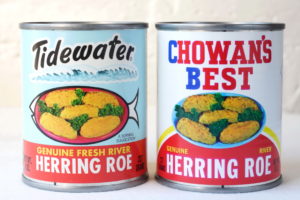 Fresh river herring roe is perfect for the food lover who wearies of fads and romanticizes the diversity of America’s eating past. It’s also perfect for anyone who enjoys word play: Canned fresh river herring roe . . . how can it be “fresh” and “canned” at the same time? It’s not an oxymoron, or worse a marketing ploy to convince you that what you’re getting is “fresh,” though “canned.” Here, the word fresh refers to the type of herring from which the roe is harvested: Once a year, in the springtime, fresh river herring leave their marine home to return to the very same river where they were born, traveling up, up, up until they reach the river’s head and can find a suitably gentle spot—in science speak, a “low-flow” area—to securely lay their eggs, and repeat the cycle.
Fresh river herring roe is perfect for the food lover who wearies of fads and romanticizes the diversity of America’s eating past. It’s also perfect for anyone who enjoys word play: Canned fresh river herring roe . . . how can it be “fresh” and “canned” at the same time? It’s not an oxymoron, or worse a marketing ploy to convince you that what you’re getting is “fresh,” though “canned.” Here, the word fresh refers to the type of herring from which the roe is harvested: Once a year, in the springtime, fresh river herring leave their marine home to return to the very same river where they were born, traveling up, up, up until they reach the river’s head and can find a suitably gentle spot—in science speak, a “low-flow” area—to securely lay their eggs, and repeat the cycle.
My guess is that the food lover in your life will not have heard of fresh river herring roe, canned or otherwise. Even in Virginia, a one-time hotbed of fresh river herring roe consumption, not many people eat it anymore. Those who do generally have sixty years or more of life behind them and grew in the mid- and South Atlantic states. I am not writing this story for them because they already know what to do with it when they run across a can of it. I am writing this story for the rest of us, who could easily go a lifetime without hearing of, running across, or eating fresh river herring roe.
Yet this food—the fish itself or the roe or both—was, from Colonial times and up until not that long ago, a commonly known and enjoyed food.
Back in the day, prior to the invention of canning, enjoying roe would have been a once-a-year delicacy, available in the early spring when the fish swam up river, from the ocean, to lay its eggs. The fish itself would be eaten fresh, as well, or salted to be preserved for later. For people living along the rivers, river herring and shad were one of the first pleasures of spring eating.
With canning, the roe became available year-round. I suppose, back in the last century, it’s possible that the year’s supply of canned roe may have sometimes ran out before the fish once again swam up river in the spring, reminding everyone that though canned, roe is a highly seasonal food. But I doubt it; the supply was just too plentiful.
But that is exactly what happens today. With just one company remaining that cans the roe and only one remaining mid-Atlantic or Southern state that permits fishing of fresh river herring, supply is tight and its future as an edible commodity in peril. That company is Cowart Seafood of Lottsburg, Virginia, and the state where is can still be fished, for now anyway, is South Carolina.
Lake Cowart, owner and president of Lake Packing Co., said that canned roe used to be so common and inexpensive that it was at the top of the list of popular cheap eats in Virginia and neighboring Maryland and North Carolina and was a staple food for the working classes. Today the cans are half the size they used to be and several times more expensive.
Their cost explains why when I first saw cans of the roe, in Cross Bros. Grocery in downtown Ashland, Virginia, they were under lock and key in a glass case, next to the packs of cigarettes. The security was no doubt mainly to keep minors’ hands off of the tobacco, because no minor would have interest in nabbing a can of fresh river herring roe for themselves, unless it were to go into a black-market scheme selling roe to grandparents.
Cross Bros. Grocery is an old-fashioned market catering to old-fashioned tastes. When it’s available, the owners like to stock canned fresh river herring roe for their older and loyal clientele, but the supply is inconsistent and varies from year to year. That is why on the day we visited the store there was a handwritten sign that announced, “We have Herring Roe” taped to the front door. I hadn’t noticed the sign when we walked into the store, but once inside, I did notice the small cans of roe—who wouldn’t have been intrigued by their unique shelving spot, regional-sounding brand names (“Tidewater” and “Chowan’s Best”), and anachronistic label designs showing a plate of small cakes or croquettes abundantly garnished with curly parsley. Their small stickers with a high price also caught my eye.
The 105-year-long history of Cross Bros. easily intersects a time when canned river herring roe was a common, inexpensive food. A 1967 newspaper coupon section for the grocery store, pinned to a back wall of the store along with other memorabilia, advertises two 16-ounce cans of roe for $1.00. This past holiday season, when I made my “discovery” at Cross Bros., an 8-ounce can of Tidewater went for $11.59. The Chowan’s Best brand was slightly less expensive option at $8.79 a can. This holiday season Chowan’s Best is priced at $10.99; they’re all out of the Tidewater brand.
With the ulterior motive of learning how to prepare the roe, I asked Cathy Waldorp, then one of the store owners, if she eats the roe. “Not anymore, not at $10 or $11 a can!” In her early sixties now, she grew up eating roe cakes prepared by her mother. Except to say that there was some egg and flour or meal mixed with the roe, Cathy couldn’t recall exactly how her mother made the cakes. But she could recall how inexpensive roe used to be and can’t stomach paying the current price.
Today’s price doesn’t scare everyone off though. Not unlike cigarettes, canned herring roe is considered a must-have product among its devotees, and they’re willing to pay most any price for it. In fact, some of their older customers, Waldorp said, will buy out their entire supply. It makes you wonder who or what will go first—the dwindling market for the roe or the supply itself.
The cashier, who looked to be in her thirties, said she’s never eaten the roe herself, but suggested I scramble it with some eggs for breakfast. “That’s how most people eat it,” she said. “Six eggs to half a can,” she added.
* * * * * * * * * * * * * * * * * * * * * * * * * * * * * * *
Lake Cowart loves fresh river herring roe so much that he eats it directly from the can.
“I think it’s delicious that way,” he said, during a phone chat, early in the year. “Some people may not care for it that way, but over the years I developed a taste for it straight from the can.”
Lake Packing Co. packs river herring roe under the Tidewater label, an old Virginia brand that has been around, Cowart estimates, for about 100 years; he purchased the label about 12 years ago. Lake Packing Co. also co-packs roe under the Chowan’s Best label, an old North Carolina label named for the Chowan River.
I called Lake Cowart not just to find out about herring roe and the Tidewater and Chowan’s Best brands, but also to get detailed instructions for preparing the roe. I was having trouble finding recipes online or in books. I hoped to get my hands on the official Tidewater brand recipe for the cakes, the ones pictured on the charming label. No such luck.
“There’s one on the label, isn’t there?,” he said. And then a moment later, after having clearly turned the can about in his hand, answered his own question. “No, I guess there’s not.”
Cowart’s assumption wasn’t misplaced; before nutritional facts and bar codes forced their way onto label designs, forcing out nonessential niceties like recipes, the label would have included one. I found at least two examples online of competing, now-extinct brands from back in the day with recipes printed on their labels. Unfortunately, the images are small and the recipes too difficult to read.
While roe cakes are what was, and still is, illustrated on cans of herring roe—probably because they’re prettier than an amorphous mass of eggs—it’s the simpler dish of scrambled roe and eggs, eaten for breakfast, that seems to have been the most common preparation. Cowart said he grew up eating the roe scrambled, not as cakes; so, though he could walk me through the basics of scrambling them and tell me what he feels is the ideal ratio of egg to roe (1 egg to one 8-ounce can), he couldn’t tell me how to make the cakes.
Though Lake Cowart was perfectly polite and patient when answering my many questions about how to prepare the roe (including the most embarrassingly basic, such as “Do you drain off the liquid in the can?”), it was clear that he doesn’t get too many calls, maybe none, about what to do with what’s inside the can.
“Most of the people who eat this product have been eating it for years, and they know what to do with it,” he said. “So, there’s not a lot of information out there telling the consumer how to consume it. We haven’t worked hard to increase the market beyond our traditional market, or promote its consumption with recipes, because we don’t have the product to supply it.”
His company does get lots of phone calls or emails, however, from people looking to buy canned fresh river herring roe who can’t find it in retail stores near them. (If you live in a state other than Delaware, Maryland, Virginia, or North Carolina, it’s a near certainty you’re not going to find it on a grocery store shelf.) Lake Packing Co. will ship the roe directly to customers, if he has the stock.
When we spoke in mid-January of this year, he’d just sold out of the 2016’s catch, which translated to 300 cases of roe. At that time, he said he wouldn’t have more until the spring, when the herring return to the rivers to spawn, assuming all goes well. When I checked back in with Lake Cowart, a few days ago, he told me that 2017’s catch was even smaller than the year prior: 200 cases total. Compare that, he said, with the amount they canned annually in the mid-eighties through the early nineties: 6,000 to 9,000 cases. And, he added, they weren’t the only company canning herring roe at the time; there were at least two others, that he knew of. Not surprisingly, he is already out of the 2017 catch.
* * * * * * * * * * * * * * * * * * * * * * * * * * * * * * *
I can forgive Lake Cowart for not having a roe cake recipe on hand to share with me. As the sole remaining American packer of fresh river herring roe, he is doing the important work keeping a highly regional and traditional food from disappearing completely. That makes him a hero.
Still, I was disappointed. By all rights, I have no rights to be nostalgic for fresh river herring roe, but I am. Even before opening my first can and giving it a try, just on principle, I was nostalgic for it. Eating fresh river herring roe, I decided, is like slipping through a time portal. For now, the door is still open, but just a crack.
The information on preparing river herring roe is so scarce, that if the fish were to disappear from our rivers tomorrow, it would almost be as if the food had never existed, even though it is described as once being very common. I did find a tantalizing reference to the popularity of canned river herring roe in the lesser-known 1941 title Look Before You Cook: A Consumers Kitchen Guide. The authors, Rose and Bob Brown, two of a once well-known author trio Cora, Rose, and Bob Brown, give guidance on herring roe in the “Canned Goods” section of their book:
“Herring Roe, the delicacy that ranks in popularity with shad roe (which also comes in cans), is not so expensive as most fish eggs and its economy can be stretched out with eggs in appetizing recipes printed on the label.”
Other cookbooks from the forties referencing canned herring roe have recipes for fish roe, if not herring roe specifically.
After searching online and looking in at least thirty old or classic cookbooks, many of them focusing on the foods of Virginia and many in the collection of the Library of Virginia, I’d found a total of two recipes using canned river herring roe, both for the scrambled preparation. (Recipes for preparing shad roe, on the other hand, though not nearly as popular as it once was, are much easier to find than the more regionally localized herring roe.)
I feared my trail would go cold. Herring roe was turning out to be a cliquish “who-you-know” food; if you know a Virginian who knows a Virginian who knows how to prepare canned river herring roe, you’re in luck. (In hindsight, a visit to a nursing home, with a can of roe in one hand and a notepad in the other, probably would have rendered results.) Perhaps it’s because canned herring roe was so common, and so regional, that, in a time when basic cooking skills were assumed and passed down, mother to daughter, published recipes for how to prepare it are nonexistent, or seemed to be.
I didn’t give up. I returned to the Library of Virginia, which is known for its large Virginia-focused cookbook collection, and in particular community cookbooks. The latter turned out to be my windfall. In a thin, leather-bound, twenties-era community cookbook, titled The League Cook Book and compiled by the Ladies of the School and Civic League of Crewe, Virginia, I found seven recipes for using canned herring roe. The Crewe ladies had clearly been resourceful in finding sources of funding for their publication: strategically located among the recipes for Tidewater roe is a half-page ad for Tidewater brand herring roe. Among the recipes for roe was one for croquettes and one for potato cakes. Armed with what I was after, it was time to open my cans of roe.
* * * * * * * * * * * * * * * * * * * * * * * * * * * * * * *
The day that I discovered river herring roe began portentously: At the Bass Pro Shop in Ashland, Virginia, staring face to face with a humongous fish that nearly outsized its two-story tank. Its grotesque size was unsettling, as if something was not right in the natural order of things; yet its slow, lumbering movements, weightless and astronaut-like, were mesmerizing and oddly quieting in the hub-bub of holiday shoppers.
As I stood there transfixed, the caretaker of the fish told the crowd about the 23,000-gallon aquarium and the fish it contained. The monster-truck-size fish, he said, is a record-setting, 100-pound-plus blue catfish, caught in Virginia. It is estimated to be forty or fifty years old.
The blue catfish, I would learn later, was introduced to Virginia waters in the 1970s as a recreational game fish. Initially a boon to fisherman, this new species, a veritable eating machine, quickly upset the balance of predator and prey in Virginia waters. It became one of several factors in the “perfect storm” that has led to the fresh river herring’s dramatically dwindling population. One by one, beginning in 2002, states up and down the East Coast have put moratoria on fishing it, commercially and recreationally. Virginia’s full moratorium on fishing river herring began in 2012 (a partial ban had been in place since 2007).
Something just had to be done. “The feeling was don’t kick the species when it’s down,” explained Joe Cimino, during a telephone chat this spring.
I called up Joe Cimino, the Deputy Chief of Fisheries Management in Virginia, to learn why the river herring is threatened. The answer he gave me is that it’s hard to say why, as of yet anyway, because the scientific data recording on the fish in Virginia began only since the fishing moratorium went into place. The reasons, he explained, will no doubt be multiple: water quality, off-shore fishing of adult herring, imbalance of predators, and urban run-off. The latter problem, I sensed, was the weightiest to him—the one that would be the most complex and complicated to resolve. It’s one thing to fix issues in the waterways themselves; it’s quite another to effect what people do on the land near our waterways.
“Clearly,” he said, “It’s going to take more than a moratorium on fishing river herring to improve its population.”
* * * * * * * * * * * * * * * * * * * * * * * * * * * * * * *
River herring is one of the first fishes to spawn, even ahead of shad, and its yearly journey inland gave Virginians something fresh to eat when the provisions of cured meats and root vegetables from the fall had started to thin, and the body tire of heavier foods. According to the Larousse Gastronomique, when caught after spawning, “the herring is said to be ‘spent’: it is only half the weight and flesh is dried.” People living along the rivers would have known this—that it’s right before they lay their eggs, when their sacks are full of roe, that their flesh is most succulent and fatty. And of course, it is before they lay their eggs that you want to catch them for harvesting roe, as well. (Lake Cowart said the prime time is a week or two before they lay their eggs.)
One early spring day, nostalgic for the centuries-long tradition of a river herring-rite-of-spring, I got caught in an unusually heavy downpour, following a spate of unusually warm days. I had just exited the freeway in downtown Richmond, when the deluge began in full force. Turning left, I headed uphill on 7th Street, which had become an impromptu river bed. A torrential flow of water sped unimpeded past my tires, grabbing cups and bags and other debris in its rapid, asphalt-lined course toward the James River.
I immediately visualized the next generation of the small, once mighty, fresh river herring—the same fish that fed Washington, that fed the revolutionary War troops—being flushed away, in a blink of an eye, by the sudden gush of water.
The spring prior, being witness to urban run-off and its efficient street cleaning service would have been enough to put me into a state of melancholy reflection, let alone the thought of herring roe eggs being blasted hither and yon. Am I contributing to the river herring’s ill health by publishing this story, and in particular by promoting the roe as the perfect stocking stuffer? If we eat the delicate pin-point-sized eggs that would otherwise turn into herring, aren’t we adding to the problem?
In theory yes, but this time, with this product, nature has thrown a mirror up, and set her limits. Then I realized, with relief, that since my blog readership is very small—“low-flow” you could say—I can sleep at night knowing this story will not cause a stampede through the time portal for canned fresh river herring roe.
But if you do manage to fish this story out of the flooded Internet, and you manage to find a can of roe, I’ve included a recipe for roe cakes for you below, assuming you’re a green roe eater. If you already have an acquired taste for roe, like Lake Cowart, then you might enjoy eating it straight up, from the can, which will save you a lot of time and effort.
P.S. Since originally visiting Cross Bros. Grocery last holiday season, the ownership of the venerable grocery has changed, but they still sell canned fresh river herring roe (though I don’t know if it’s still shelved next to packs of cigarettes).
Tidewater Roe Potato Cakes
If you enjoy the flavor of all types of fish, including the deeper, richer flavor of oily fish, sardines or anchovies or blue fish, for example, then you will enjoy the flavor of these roe cakes. When making roe cakes, it’s more common to mix the roe with bread crumbs or cracker meal (or perhaps flour) than mashed potatoes, but I love the pillow-y texture they give to the cakes and enjoy the more mild and subtle taste of potato-based cakes. Other than the addition of some chopped cooked bacon and a hint of cayenne pepper to the cakes, and opting to coat them in bread crumbs, my modernized version of this circa 1926 recipe is faithful to the Ladies of the School and Civic League of Crewe, Virginia. I find these cakes absolutely delicious served with squeeze of fresh lemon.
For the cakes:
- 1 (8-ounce) can herring roe
- 1 cup cold mashed Russet or Idaho potatoes (1 medium potato, 8 to 9 ounces, see Note)
- ½ cup finely chopped onions (about 1 small onion)
- ¼ cup finely chopped cooked bacon, fat trimmed (optional) (see Note)
- 1 egg, well beaten
- 1½ tablespoons extra-fine cracker meal, extra-fine bread crumbs, or flour
- 2 teaspoons finely chopped fresh parsley (about 2 sprigs)
- ½ teaspoon salt
- ¼ teaspoon ground black pepper
- 2 pinches of cayenne pepper
For the coating:
- 1 egg, well beaten
- 1 cup bread crumbs
Bacon fat, for frying
Lemon wedges, for serving
- Mix all of the cake ingredients together until well combined. Place in the refrigerator to chill up and allow flavor to marry for at least 2 hours or up to overnight.
- Form into 14 small cakes, about ¾ inch thick, or croquettes. If you have time, place them a wax paper-lined tray and set them in the freezer for 30 minutes to firm up; this will make them easier to handle in the skillet.
- When you’re ready to fry the roe cakes or croquets, heat up a large cast-iron skillet over medium heat until it is very hot and beginning to smoke, about 5 minutes.
- Dip into the egg, then into the bread crumbs.
- When the skill is hot, put 2 to 3 tablespoons of bacon fat in the pan.
- When the fat is hot, fry the croquettes until golden brown on both sides (or all sides if making croquettes), turning them gently. Fry them in batches if needed so as not to over crowd the pan. Serve with lemon wedges. Makes 14 small cakes or croquettes.
Notes:
- You will need about 2 thick-cut slices bacon to end up with ¼ cup finely chopped bacon.
- To prepare mashed potatoes for croquettes, peel and quarter potatoes and put in a pot. Cover generously with cold water and bring to a boil over high heat. Add 1 teaspoon of salt to about 3 quarts of water, lower the heat to medium-high, and continue to boil until the potatoes are tender, about 15 minutes. Drain and let cool to room temperature, then mash.
- To make your own cracker meal, put saltine crackers in a heavy plastic bag and rolling them with a rolling pin or place crackers in a food processor and pulse until the desired texture is achieved.
Gallery of other roe preparations:

Scrambled roe with egg, the most common preparation. It’s tasty enough, but I think probably a favorite of folks who grew up eating it this way. If you’re new to eating roe, I suggest you make roe cakes. It’s delicious that way.

My invention: A large roe cake served over mixed salad greens and a topped with a poached egg. It makes for a very good looking and tasty meal, but I think the croquettes served simply with lemon wedges is even better. The subtle flavor of the roe cakes shines more clearly with less going on on the plate.
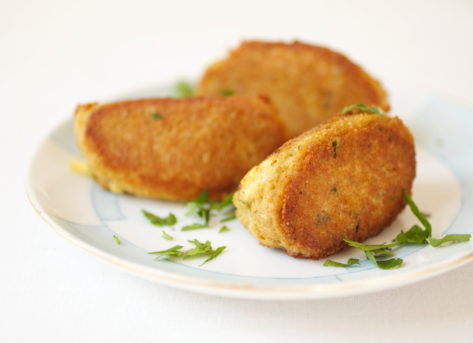
The roe made into croquettes with cracker meal only, no mashed potatoes or cracker meal coating. While prettier than the cracker coated, potato-based version, I prefer the flavor, consistency, and texture contrast the potatoes and meal coating provide.

The potato-based, meal coated cakes, my favorite version, shown with a lemon wedge. Don’t forget to serve the cakes with lemon; it’s crucial.

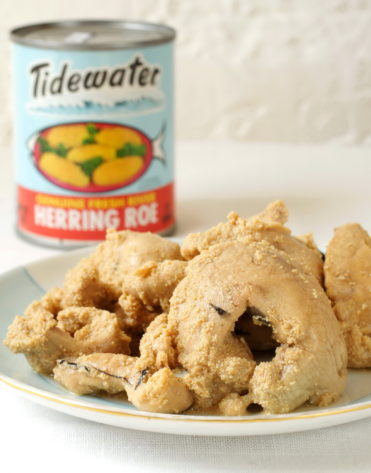
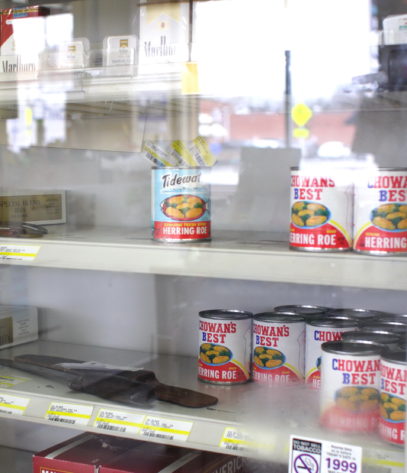


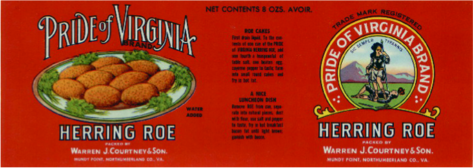
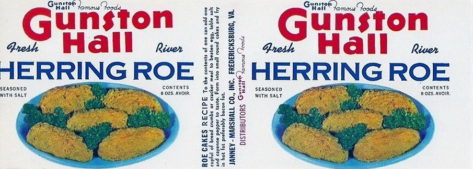



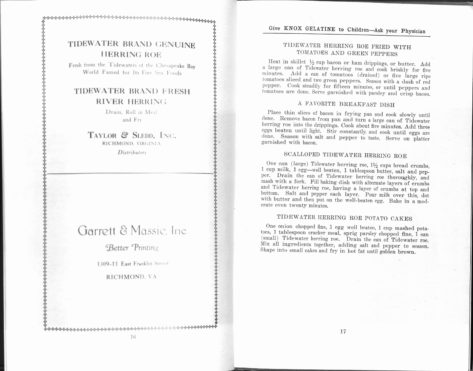
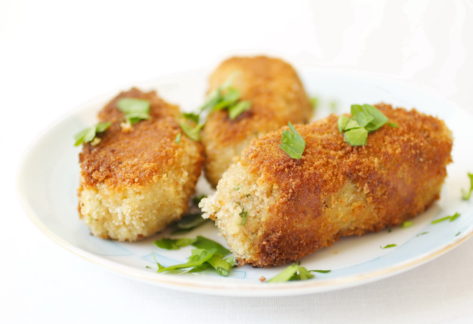
Oh my, what a splendid piece of history, research, and temptation for an all-things-fishy lover – as well as a sad tale of loss. Have had assorted preps of salmon, sturgeon, lump-fish, lobster, sea urchin, and scallop roe, but never herring. May I be so bold as to say I hope you can save a tin for out-of-area friends to taste! (Isn’t it interesting the French sell sea scallops – coquille St. Jacques – with the roe = ‘coral’. But, Americans throw it away…?)
1Glad you enjoyed the story. Seeing as you’re an experienced fish and seafood eater, and a world traveler, it just goes to show how regional and old-fashioned fresh river herring roe is. Thank you for mentioning the roe that is attached to scallops in France. We Americans do throw too much away, food and otherwise (historic architecture included). I’m going to keep my eye open for scallops with roe still attached. You’ve peaked my interest.
2Can’t wait to ask my 88 year old Tidewater father in law about Shad Roe vs. Herring Roe! He eats both. My mother in law makes it for him once a year and ceremonially serves it to him, the only roe eater in our family. I wonder if next time he’ll share with me?
3What a unique opportunity to taste roe prepared by someone who knows exactly what to do with the stuff, and who has been preparing it for years. I’m envious. I hope you can be there looking over your mother-in-law’s shoulder as she makes it. Take notes!
4I ate it growing up visiting my grandparents in Virginia every year. And yes, I’m over sixty! True what you say that there was no recipe and it was CHEAP! I started buying it online from Nixon Fisheries a few years ago and was so glad to have found them.
5Ms. Jennings:
6I had long been curious about herring roe, but never really considered springing for a tiny can of something that might not be eaten by anyone else in my household. When Kroger left Durham and Raleigh, North Carolina recently, hoping to shift business to their higher-price lower-wage subsidiary Harris-Teeter, I availed myself of the opportunity to acquire a half dozen cans for fifty cents apiece. My wife and children will need to be more open-minded than they sometimes are when they detect that the salmon croquettes I occasionally serve them are not salmon at all.
Thank you for your excellent research.
Hello Frances, so nice to hear from you. Thank you for finding and reading my story. And I apologize for not repying earlier. How did you tend to eat it at your grandparents’ house in VA, and how do you prepare it yourself these days? I’d love to hear. Have you managed to pass on a taste for it to the younger generations in your family? That seems a tricky thing to do . . .
7Dear Mr. McDuffee, Thanks for writing to me and sharing your story about the roe, and please accept my apologies for not writing to you earlier. Hah! I love your tactic of sneaking roe into “salmon croquetes”. Simply by being willing to try it and serving it to your family helps to carry on the tradition. It’s so rare for younger people to have a taste for it; you’re doing your part to right that situation! Now all we need is for a healthy population of herring to return to our rivers. Because you’re right–who is likely to try something so unusual to most tastes when it’s also priced so high. Only a niche population of food adventurers.
8I grew up in Danville, VA, and fish roe cakes were a staple in my mother’s pantry. I still make them with roe ordered from North Carolina.
I have tried my best to transcribe the herring roe recipes from THE LEAGUE COOK BOOK. Alas, the resolution in not good enough for me to complete that task. Would it be possible for you to send a transcription of those 7 recipes. An e-mail attachment would work fine. Here’s hoping!
In any case, I thoroughly enjoyed reading your article about fresh water herring roe. Thank you.
9Hello Randy, Thanks for reading my story. I’m glad you enjoyed it! It’s nice to know of Virginians (and North Carolinians) carrying on the tradition of eating herring roe. I know of a Herring Festival in NC, and would love to go sometime. Have you been to that? I will happily send you the recipes for herring roe that I found in The League Cook Book.
10I am 66 and grew up in Norfolk and remember eating both Chowan and Tidewater brands as a young boy. Sometimes as the full roe that had been rolled in saltine cracker crumbs and fried in bacon grease or scrambled with eggs.I miss that treat and wish I could find a source on the eastern shore of Maryland. Enjoyed reading your article and reliving a past delicacy.
11Andrew, I’m happy my story brought back memories for you. As more people, like yourself, comment on this story, it’s becoming clearer and clearer not just how common herring roe used to be in VA, NC, and MD but also how loved it was. For sourcing it, have you tried a Kroger’s grocery store? When there is stock available, here in Richmond you can sometimes find it at Krogers. (And by the way, you’re making my mouth water just about know–that talk about rolling it saltine crackers crumbs and frying in bacon grease.)
12Wonderful article. I grew up eating roe with my grandparents and have continued. I’m currently in my 30s and look forward to cooking hearing roe every year for Christmas morning breakfast. It’s harder to find, but I was able to get some this year in Richmond. My preference is the scrambled eggs method with some bacon. Thanks again for writing this.
13I’m very happy you came across my story about herring roe, and enjoyed it. I love your Christmas morning tradition of eating roe. That is wonderful. And nice to hear that someone in their thirties, such as you, is keen on roe and carrying the tradition forward.
14At 68, I cherish my Richmond, VA memories of of having my grandma’s (and mother’s who prepared just like grandma) herring roe patties, fresh-made hot buttered spoon bread souffle style-a true delicacy, fried apples and intermittently a whole fish that had both roe and herring fishy, salty and very good mixed with spoon bread! Luckily, cannot get these great old 1950’s breakfast’s out of my mind and taste! I am continuing to try to recreate.
15Oh my goodness, Sharmon, those are incredibly vivid and delicous-sounding memories. Spoon bread for breakfast! What a civilized way to start the day. If you come up with recipes for all of those components, I’d love to share them on this blog and call it the “Sharmon Paschal Thorton” breakfast. The whole fish with the herring would of course be the hard part today, given the fishing ban, but the rest could still be accomplished.
16